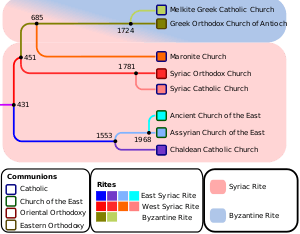Hértevin language
The Hértevin language is a modern Eastern Aramaic or Syriac language. It was originally spoken in a cluster of villages in Siirt Province in southeastern Turkey. Speakers of Hértevin Aramaic have emigrated mostly to the West, and are now scattered and isolated from one another. A few speakers remain in Turkey.
| Hértevin | |
|---|---|
| ܣܘܪܬ Sôreth | |
| Pronunciation | [ˈhɛrtəvən], [ˈsorɛθ] |
| Native to | Turkey |
| Region | Siirt Province |
Native speakers | 1,000 (1999)[1] |
Afro-Asiatic
| |
| Syriac (Madnhāyâ alphabet) | |
| Language codes | |
| ISO 639-3 | hrt |
| Glottolog | hert1241[2] |
Origins
Hértevin was 'discovered' by linguist Otto Jastrow in 1970, and first described in publication by him two years later. His recordings of the language are available on Heidelberg University's Semitic Sound Archive.
The speakers of the Hértevin dialect of Neo-Aramaic are traditionally Chaldean Catholics. Their area of habitation in and around the village of Hertevin (called Hertevinler in Turkish and Härtəvən in Kurdish), near the town of Pervari in Siirt Province is at the very northeastern extreme of the area where Eastern Neo-Aramaic languages were traditionally spoken. Thus, Hértevin is a peripheral dialect that has developed quite differently from related languages.
All Hértevin speakers are bilingual in Kurdish, and many also speak other languages. The Syriac alphabet is used for writing, but almost no literature in the Hértevin dialect exists. Church liturgy is in Syriac.
Phonology
Its major phonetic feature is the loss of the voiceless velar fricative x, which has become a voiceless pharyngeal fricative, ħ. The original voiceless pharyngeal fricative has retained that pronunciation. In all the other dialects of eastern Neo-Aramaic the opposite is true: the voiceless pharyngeal fricative has been lost and merged with the voiceless velar fricative.
Another feature of Hértevin Neo-Aramaic is its set of demonstratives. As with other languages of the eastern group, Hértevin makes no distinction between 'this' and 'that', and uses a single set of pronouns to cover both meanings: āwa (m. sg.), āya (f. sg.) and āni (pl.). However, unlike the other languages, Hértevin has developed an emphatic form of these pronouns that indicates 'this one right here': ōhā, ēhā and anhī.
Although belonging to the eastern, or northeastern, group of Neo-Aramaic dialects, Hértevin shares some features with the Turoyo language, of the central group, originating from nearby Mardin Province.
See also
References
- Hértevin at Ethnologue (18th ed., 2015)
- Hammarström, Harald; Forkel, Robert; Haspelmath, Martin, eds. (2017). "Hertevin". Glottolog 3.0. Jena, Germany: Max Planck Institute for the Science of Human History.
Further reading
- Jastrow, Otto (1990). Personal and Demonstrative pronouns in Central Neo-Aramaic. In Wolfhart Heinrichs (ed.), Studies in Neo-Aramaic, pp. 89–103. Atlanta, Georgia: Scholars Press. ISBN 1-55540-430-8.
- Maclean, Arthur John (1895). Grammar of the dialects of vernacular Syriac: as spoken by the Eastern Syrians of Kurdistan, north-west Persia, and the Plain of Mosul: with notices of the vernacular of the Jews of Azerbaijan and of Zakhu near Mosul. Cambridge University Press, London.




